Saturday 4th July 2020
It’s been another week of mixed message muddles, inconsistencies and questionable priorities.
No, I’m not referring to today’s reopening of pubs while schools pretty much remain closed until September. Nor fast food outlets up and cooking, while gyms stay closed. Even though such misplaced priorities are questionable enough.
I’m all about public transport mixed messaging, inconsistencies and priorities.
But at last, on Friday, news filtered through the ‘avoid public transport’ mantra which has been doing so much damage to the image of bus, tram and train travel these last few weeks, is set to be toned down and as early as next week. (That’ll just leave all the yellow and black hazard warning tape to dispense with and we really will be back to normal……ish)
It’s certainly a good old British bounce back boost with bus and train timetables returning to some semblance of normal as well as a welcome return of more furloughed express coach routes. But of course these inconsistently came this week alongside the, for now, continued official Government messaging to “avoid public transport” and lots of #EssentialTravelOnly imploration.
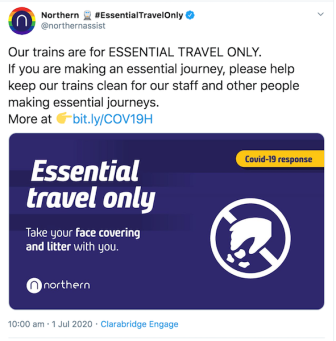
What’s a prospective passenger in the north east community of Horden, County Durham supposed to think? On the one hand being SHOUTED AT on social media that Northern’s trains are for “ESSENTIAL TRAVEL ONLY” yet a brand new “multi-million-pound station” opened for business on Monday? It’s not exactly going to ‘regenerate the area’ unless passengers are allowed to use it without being damned by breaking wartime like travel restrictions.
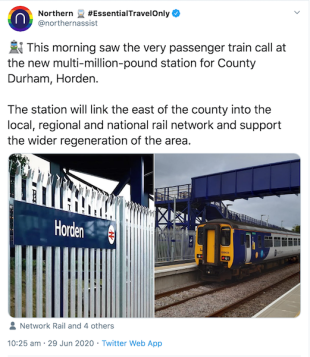
‘Ramping up’ has been all the rage these last few Covid months, but Horden has shown what serious ramping up looks like. I guess it worked out cheaper than installing a couple of lifts.
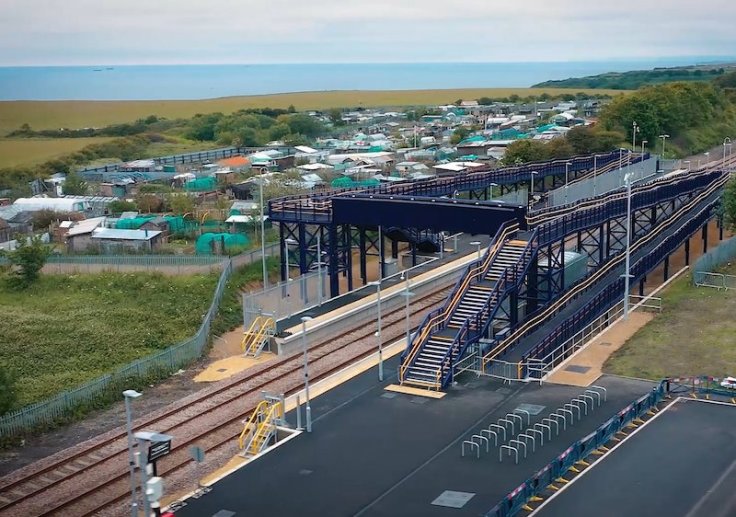
Those expanded train timetables from this weekend bring news of new peak hour trains from Eastbourne and Chichester to London Bridge. But be warned, they come with inbuilt brand confusion as this photo from Geoff Marshall advises ….
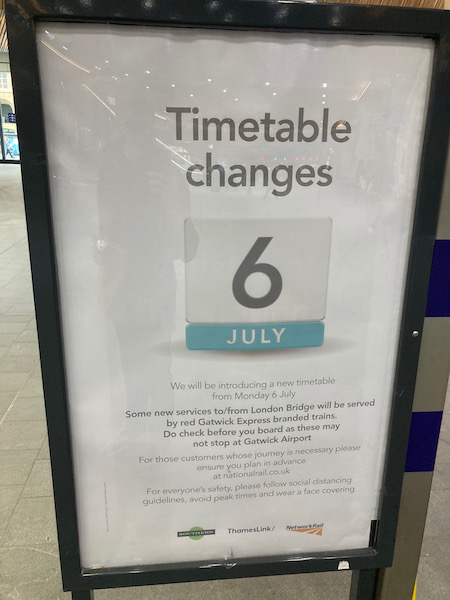
…. with red Gatwick Express trains which won’t stop at Gatwick Airport. And I won’t get started on whether tickets marked ‘not Gatwick Express’ can be used on them!
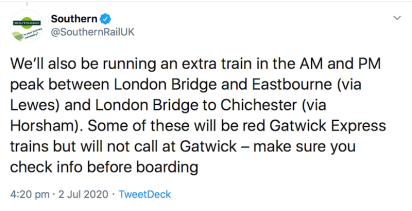
(They can.)
Meanwhile more on the mixed messaging front from Secretary of State Grant Shapps who gave a thumbs up welcoming back National Express coaches to the roads on Wednesday. “Helping Britain to get moving once again!” he enthusiastically tweeted …
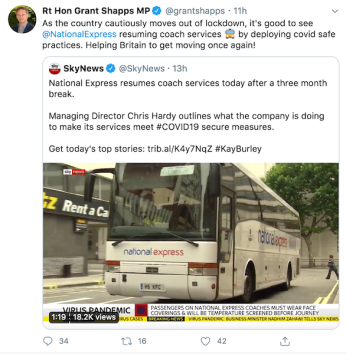
…. while his own DfT’s Twitter feed promoting bus open data – “we’re opening up bus data …. to improve journeys for passengers. So next time … take the bus!” says the profile heading, while just above comes another shouty blue and yellow exaltation “If possible, walk or cycle or go by car”. Which presumably means, don’t take a coach either.
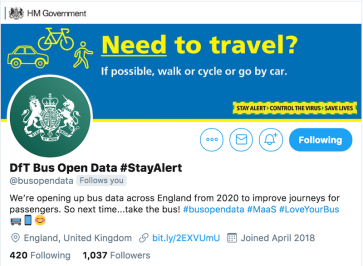
Just what is a prospective passenger supposed to make of that?

Promoting that relaunch was straight-out-of-bed early riser NatEx managing director Chris Hardy on Sky’s breakfast TV programme on Wednesday. NatEx have opted for a ‘window seat only’ regime not worrying about the alternate row layout adopted by others.
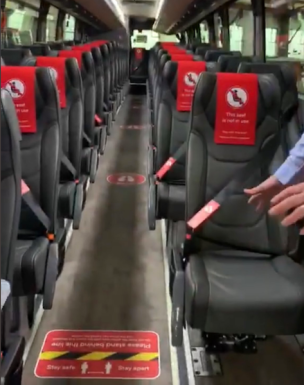
This means they can offer 50% capacity rather than languishing down at 25%, which most bus and train companies continue with, including Megabus who also hit the road again on Friday.
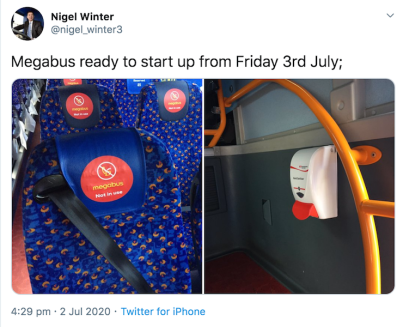
So how is it Grant Shapps is endorsing “covid safe practices” on NatEx coaches and continues to insist train companies are restricted to 25% capacity on inter-city routes? It doesn’t make any sense; certainly not to getting-fed-up-with-staying-at-home-while-all-these-inconsistencies-continue me. Shall I start travelling again on the ‘not-restricted-to-travel-for-essential-purposes-only’ National Express coaches; or perhaps even take a flight where my custom will be warmly welcomed by airlines starting back up, or follow those blue and yellow exaltations to walk and cycle everywhere, or drive?
Michael O’Leary was also doing the breakfast TV studio milk round on Wednesday promoting the return of Ryanair’s planes. They have no seat capacity limitations at all. O’Leary said with face coverings and forward facing high backed seats, side by side, the risks were minimal. That sounds no different to a train to me.

Susanna Reid pointed out food and drink will be sold on board and O’Leary acknowledged masks would be lowered for that to be consumed. Meanwhile on inter-city trains, food and drink is no longer available on board nor encouraged to be consumed – such abstinence is just not practical on a long “essential” journey from London to Scotland or Penzance.
The return of NatEx and Megabus also brings into sharp focus continuing contrasting funding regimes. While every passenger travelling on a train is being State supported by a substantial £100 subsidy per journey with a carriage to themselves, express coaches are providing an alternative at no cost to the taxpayer at all.
Not only that, but international coach operator FlixBus has now joined the UK express coach party beginning three new services on Thursday.

What a time to launch new express coach routes. I presume the equity backers of Flixbus do know there’s a bit of a global pandemic going on at the moment causing a devastating impact on travel habits? The German based company is now running two daily return journeys on three routes with six coaches (provided by outsourced operators) between London and Birmingham, Bristol and Portsmouth (with a stop in Guildford). I presume they also know First Bus gave the Portsmouth run a good going over with their high profile Greyhound brand ten years ago (overseen by the enthusiastic customer centric Alex Warner who threw everything at it he could get away with in First Group’s corporate strait-jacketed regime of the time – which actually was quite a lot, bearing in mind it was Alex)? It still failed. Bristol was also targeted by newcomer Snap until that operation became furloughed for Covid, while Birmingham is always a popular market, not least with hefty rail competition leading to some bargain basement fare offers. It’s not going to be an easy ride for Flixbus.
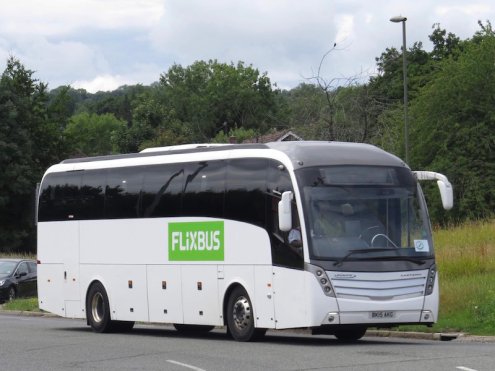
Many thanks to Gabriel Fong for the above photo capturing a former Whippet Coaches vehicle on the 11:00 from London to Portsmouth in Guildford on the first day, Thursday and to Scott Cooper for the timetable below.
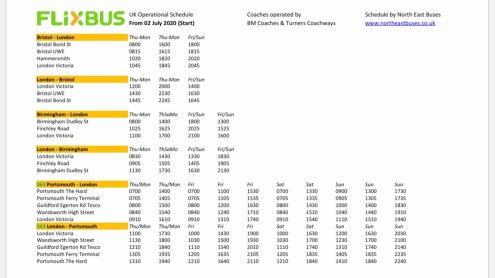
It has to be said, Fixbus have expanded fast across much of Europe and even in the USA. And they’re ambitious. “This is just the beginning,” Flixbus UK managing director Andreas Schorling said in a statement. “We have great plans for Britain and want to become the market leader by 2025.” I’ve got a feeling NatEx and Stagecoach owned Megabus might see that a bit differently. Flixbus is using “local, authorised coach firms, which are often family run … with fares starting from £2.99. Initially, the offer will entail around 200 trips a week”. One to watch especially as some of their expansion has come from buying out other operators (eg Megabus in Europe). Hmm, there’s a thought.
Meanwhile over in Watford, the Borough Council’s generously funded DRT scheme got underway on Wednesday and Arriva Click even managed to update their website to confirm it was indeed all up and running by lunchtime that day. So that was a result.

Once I realised Arriva Click in Watford needs a different app to download than Arriva Click in Leicester and Arriva Click in Speke (and previously in Liverpool and Sittingbourne) – they use algorithm experts called ‘ioki’ in Watford rather than the more usual ViaVan, so you need your wits about you when downloading from the app store to choose the right Arriva Click App from the two available – I was all equipped at 13:04 to order up a minibus to come and pick me up from my imaginary location outside Watford Junction station. A minibus would be with me in seven minutes, which wasn’t bad, although I doubt the minibuses were exactly stretched with custom at lunch time on the first day.

There didn’t seem to be a facility to register a concessionary pass, and I thought the £4.50 price a bit ‘taxi-like’ for an approximate 16 minute journey, so decided against booking and instead to stay home, stay alert and save lives.
Three minibuses are providing a service limited to a Covid-safe four people per bus in these intial first few weeks, but that shouldn’t be a problem in the slim-pickings world of DRT. I hope to get to Watford to give it the usual “busandtrainuser once over” soon but am torn between continued abiding by the “avoid public transport” mantra and being tempted by all these exciting new services starting up.
Talking of new services, last week I highlighted Bracknell Express branded route 99 to Heathrow Airport starting in ten days and on Tuesday evening came surprising news of Grand Central’s grand return to the tracks from Sunday 26th July.
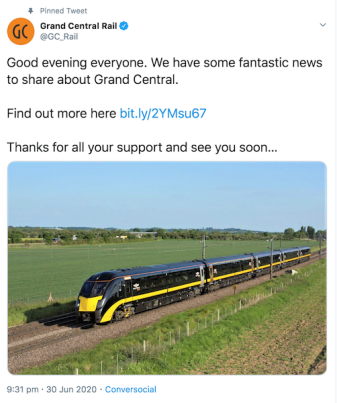
Three return journeys will run between Sunderland and London with two from Bradford. Except, you struggled to find that out as the company’s website had a glitch on Tuesday and Wednesday just as Grand Central tweeted out the “fantastic news” including a link to the broken website. Thankfully it soon got sorted and a kind knowledgable tweeter suggested I had to refresh the page which seemed to crack the problem.
It’s commendable to see the return of an open access train operator back on to the tracks at its full commercial risk with no Government financial support but I reckon Grand Central are going to have their work cut out to make anywhere near a financial return particularly while Government’s negative stance towards public transport continues.
Another welcome return is to Blackpool’s trams in a couple of weeks after the system was sensibly mothballed shortly after lockdown to save the high costs of running a fixed track system. Blackpool Transport also announced the ending of free travel for NHS staff applied from Wednesday. Another sign of normality returning and another reason why the upcoming avoidance of the ‘avoid public transport messaging’ can’t come soon enough.

Grant Shapps has pinned his faith on e-scooters becoming the next big mobility thing. Yes, we’ll soon be scooting our way up the A1 from London to Sunderland as from this weekend local authorities can allow companies to rent them out “to help ease the burden on public transport”. What burden? Did I miss something? The only burden on public transport has been the negative messaging and slavish social distance requirements.


As the move was announced, the Transport Select Committee began an evidence session on the subject ‘e-scooters: pavement nuisance or transport innovation?’
The Parliamentary Advisory Council for Transport Safety (PACTS) are not quite so enthusiastic. They reported “from evidence around the world, it is now very clear the public benefits (of e-scooters) are illusory and the disbenefits substantial … very few car trips transfer to e-scooters … predominantly trips made previously on foot, cycle or public transport, or new trips.” They go on to say “e-scooters are not active travel, they involve no physical exertion and provide no health benefit to the user … they tend to reduce active travel”. They also point out the dangers for both users and to other road users.
Talking of e-scooters, Alex Hornby made the pertinent point on social media that along with cycling and walking, they’re simply not able to do the “heavy lifting” of providing a mass transit alternative to the bus. As car use continues to grow back towards pre-Covid levels, bus and train use continues to languish thanks to all the negative messaging. It’s that messaging which simply has to change. Or … #ChangetheMessage …. as they say these days.

All the more so on Thursday with Government announcing schools will be fully opening from September when it’s inevitable school buses will need the flexibility to carry children at normal on board capacity levels with no social distancing restrictions. So why not bring it forward and allow normal capacity now, to coincide with pubs reopening? I delved into the Government guidance on ‘full opening of schools’ issued on Thursday to take a look at what will be involved.
It’s going to be all about bubbles in school: “if class-sized groups are not compatible with offering a full range of subjects or managing the practical logistics within and around school, they can look to implement year group sized ‘bubbles’”. Then there’s this advice a bit further on ….
Measures for arriving at and leaving school
We know that travel to school patterns differ greatly between schools. If those patterns allow, schools should consider staggered starts or adjusting start and finish times to keep groups apart as they arrive and leave school.
So how’s that going to work? How are year group bubbles going to be kept separate on school buses? It’s just not practical as, presumably year group bubbles don’t necessarily live on the same bus route.
Luckily a journalist from a publication called Schools Week was on to it and asked Education Secretary, Gavin Williamson, at Thursday’s Downing Street Briefing: “a lot of pupils particularly those at rural schools rely on public transport to get in to school, doesn’t your plan for bubbles full apart when children are crammed on to buses to and from school every day and given the importance of this why are you still evaluating your position on providing extra school transport services; why don’t you have a plan already?”
Steal yourself for the lucid reply from our Gav…

“In terms of school transport this is an issue we’ve been working on very closely both with the Department for Transport, the Ministry of Housing, Communities and Local Government and we’ll be working very closely with local authorities in terms of making sure, depending on where we are in terms of dealing with this virus, that the proper controls are properly in place on school transport and some of the information that we are sharing is making sure that the protection of those bubbles is in place as a result of home to school transport.”
So that clears that up then!
It looks to me those bubbles are soon going to burst.
Over at BBC Essex there was even talk that there’d be no school buses at all…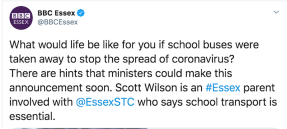
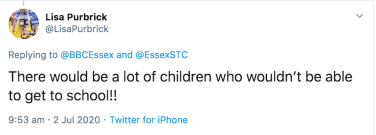
Lisa Purbrick seemed to know what she was talking about. Hopefully it was just one of those controversial topics beloved of local radio ‘mid morning matters’ programmes to ‘engage with their listeners’ and I’m guessing the “hints” are totally spurious.
Can you imagine school kids assiduously wearing face coverings, sitting in silence and keeping the requisite social distance apart on school buses? I can’t. Up in Scotland, there’ll be an interesting dry run for England as their schools go back on 11 August.
It was announced on Thursday that face coverings will be mandatory in Scotland’s shops (as well as already on public transport) from next Friday. That might help with community acceptance and enforcement which I see is a problem in some areas, not least in the Potteries where people got excited about it during the week.
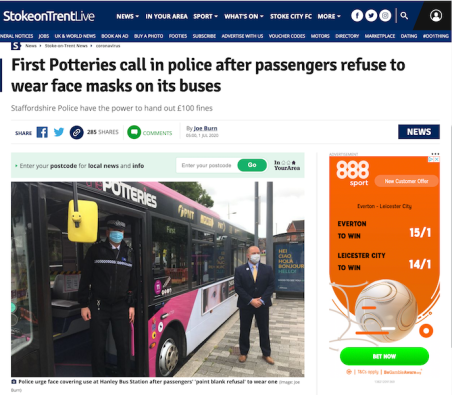
There were reports First West of England are planning to introduce a whacky idea shortly whereby bus passengers in Bristol will be able to reserve a seat on socially distanced bus services in a trial this summer. “Subject to the effectiveness of the pilot, the project has the potential to expand onto other routes across the network where demand is expected to be at its highest and capacity at a premium,” Peter Mann, the West of England Combined Authority’s head of strategic transport, told councillors. He said the trial was expected to launch in late-July. FirstGroup’s current thinking apparently is the reservation system will be offered on duplicate services – the additional services provided to facilitate social distancing on a busy bus route. The normal services on the route would remain open access. A better idea would be to ditch the yellow and black tape.
The beleaguered coach sector took the initiative to raise its profile on Wednesday with a ‘Honk for Hope UK’ convoy of 90 coaches hitting the roads in the north east. Organised by Jenna Rush of Newcastle based North East Coach Travel. Jenna pointed out “social distancing prevents coaches from being filled to capacity, reducing revenue as a result.”. It was a good high profile stunt to raise the profile of the coach sector not really going anywhere which contrasts with Michael O’Leary just getting on with it and flying again.

Back in Scotland Michael Matheson the Scottish Government’s Transport Secretary announced additional funding of £46.7 million for bus companies with an expectation they will “progressively ramp up services”. But it was also reported this week Strathclyde Partnership for Transport (SPT) needs “urgent financial aid from Transport Scotland” as it faces a £12.5 million shortfall for the current financial year with expectations it could rise to £20 million. SPT CEO Gordon MacLennan said he’d written to Transport Scotland three times since March but “not a penny” of support has yet been received. Much of SPT’s income comes from the Glasgow Subway where passenger numbers have fallen by 97%. There are similar issues on Lothian’s trams in Edinburgh.

A Transport Scotland spokeswoman was quoted as saying: “we appreciate the important role that the subway and trams play in our two biggest cities and have undertaken detailed discussions with SPT and Edinburgh Trams to understand the implications of Covid-19 on their operations. We are currently exploring what appropriate support may be available in the context of the very challenging financial situation, our published Covid-19: Framework for decision-making, and the Transport Transition Plan.”
No rush.
Talking of no rush, buses in London have been slowly returning to front door boarding week by week. Ten more routes swap back from today, but that still leaves 20 with middle door boarding meaning no fares being collected. Lucky passengers are those using routes 39, 80, 93, 108, 131, 151, 152, 154, 163, 219, 227, 232, 286, 355, 358, 365, 455, 476, 485 and 486.
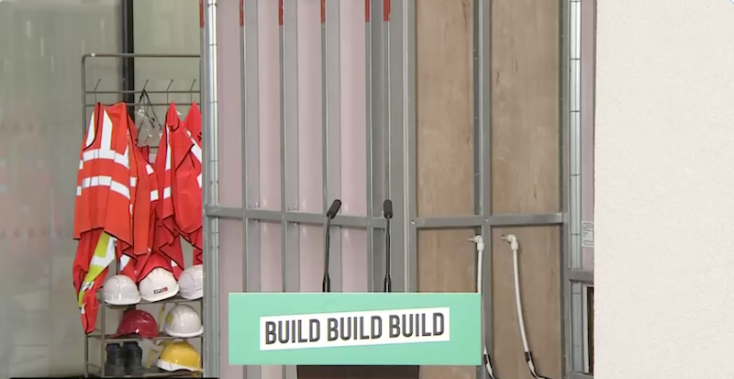
On Tuesday we had the benefit of the Prime Minister’s much hyped ‘build build build’ vision for post Covid Britain (even though experts are cautioning we’re not, in any sense, in a post Covid position). I scoured the speech for references to a vision for public transport to build build build in the benefits we’ve all seen of improved air quality when traffic dramatically reduced. After the usual wiffle waffle and piffle paffle came this gem: “and more than ever the time has come when we must unite and level up in the most basic way possible not just with HS2 and NPR but with better roads, better rail unblocking the central Manchester bottleneck that delays services across the north and 4000 brand new zero carbon buses and a massive new plan for cycleways and we will build and rebuild those vital connections to every part of the UK”.
I’m guessing not too many listeners recognised the acronym NPR. I had to think for a while and then realised it was ‘Northern Powerhouse Rail’. It will be interesting to see what the “central Manchester bottleneck” involves. Grant Shapps told the Transport Select Committee when questioned on this last week that his investment of digital signalling on a section of the East Coast Main Line was the answer. Personally I doubt that would make the 11:03 from Hazel Grove to Blackpool keep to time through Deansgate any time soon. Now it seems there’s £10 million going Network Rail’s way “for the design stages of works focused on Manchester’s railway system”. It’ll be interesting to see if this brings back the quadrupling of the track through Oxford Road and Deansgate proposal which Grayling reckoned wasn’t needed. It was.
Those “4000 brand new zero carbon buses” will be welcomed by the UK’s bus manufacturers who face a bleak short and medium term future, but they’ll need commercial bus companies’ getting their networks sorted for the new 80% (at best) of pre Covid passenger levels. Meanwhile the PM’s grand “New Deal” included 29 road projects so “we will not just bounce back, we will bounce forward – stronger and better and more united than ever before”. They comprise £4.9 million to repair two bridges in Sandwell, £5 million to make Liverpool’s road network more resilient, further maintenance on the Swanswell Viaduct in Coventry, and road maintenance in Tadcaster, £4.9 million for replacing poor quality pavements in Sheffield and another £4.5 million for improvement works on the A15. That’s quite some New Deal. I wonder if Roosevelt ever travelled along the A15 on a visit.
CPT’s Graham Vidler didn’t seem quite so convinced by the minimal mention of buses by our bus loving Prime Minister, reacting after the speech by saying “despite delivering £10s of billions to the economy each year buses are often forgotten in transport planning meaning they become stranded in congestion, which we know causes economic harm”. Let’s hope in pledging to do away with the red tape of “newt-counting delays in our system” we don’t forget the all important role of public transport as new developments spring up as we build, build, build …. luxury flats on a former printing works site, for example.
Never mind buses being ignored in future developments, the omens from some of these temporary schemes being ‘fast-tracked’ in towns and cities are not good. Tom Bowell pointed out this week how the London Borough of Croydon’s closure of parts of Katherine Street and High Street has a “terrible effect on buses – southbound journey times extended up to 5 minutes and parts of busy High Street have no southbound bus stops anymore”.
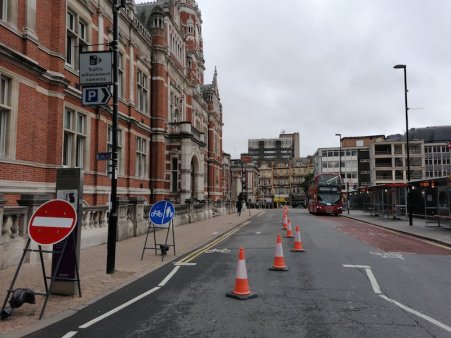
Croydon was in contrast to Salisbury where the city centre “is set to be cut off to all through traffic from September”. A move warmly welcomed by bus operator Salisbury reds who maintain the access it needs. So that sounds good.

 Meanwhile, as a foretaste of whats to come it’s reported Transport for London is looking to reduce its office estate with many of its desk-based staff home working. TfL’s director of commercial development Graeme Craig told the finance committee how TfL “went from having some 12,500 people working in our major office hubs to having … only 500 people …in offices” He said the changes could be long lasting “we expect the organisation to work very differently …. this is a unique opportunity to move to a model of working that delivers substantial cost savings and efficiency gains”. And remember TfL is all about transport where “every journey matters”. Hundreds of companies not focused on delivering transport as a business are bound to be thinking similarly.
Meanwhile, as a foretaste of whats to come it’s reported Transport for London is looking to reduce its office estate with many of its desk-based staff home working. TfL’s director of commercial development Graeme Craig told the finance committee how TfL “went from having some 12,500 people working in our major office hubs to having … only 500 people …in offices” He said the changes could be long lasting “we expect the organisation to work very differently …. this is a unique opportunity to move to a model of working that delivers substantial cost savings and efficiency gains”. And remember TfL is all about transport where “every journey matters”. Hundreds of companies not focused on delivering transport as a business are bound to be thinking similarly.
As another foretaste of things to come, over in New Zealand where they’re now a month on from public transport getting back to normal on 8th June, Andrew Dyer, my colleague managing director from Brighton & Hove’s neighbour Stagecoach South in the days when we both plied a living on the south coast, got in touch from his retirement pastures out in New Zealand to tell me:
“I thought you might be interested in our experience on the other side of the world. As has been well documented, the NZ Government went in hard and early with lockdown which seems to have paid off. The UK has 14 times the population of NZ but 185 times the number of Covid cases.” (OK, Andrew don’t rub it in.)
“During the first 4 week total lockdown, people were only allowed to use their cars to go out for food or medicine and public transport was restricted for essential workers only. Local buses and trains are all franchised here, so frequencies depended on regional council area. In Auckland, mainly Saturday timetables operated.
“When lockdown eased and required social distancing was reduced to 1 metre. Buses were allowed to carry about 40% of capacity, so everyone got a double seat with no one in the first row behind the driver. There was still an “avoid using public transport if you can” message being put out by Government.
“For the last 3.5 weeks we have been at the NZ Government’s ‘Alert level 1’ which basically means that all restrictions are removed but borders remain closed. Sadly, bus passenger numbers have been slow to rebuild and on my local route are still only about 40% of pre-Covid levels. I’m told that the best recovered route in the city is still only up to 70-75%. I sense that lots of city centre businesses are allowing large amounts of home working to continue and I have no doubt that three months of “you’ll die if you catch a bus or train” sort of messaging has taken its toll…..
Not a good omen for the UK industry.”
Not a good omen indeed, but we must keep positive. And believe in public transport. As it is the answer.
In other news this week Transport Focus published the results of its annual National Rail Passenger Survey on Thursday. Main fieldwork began on 27th January but was curtailed on 16th March due to Covid-19 so sample sizes are about 75% of normal levels, although it’s still based on almost 20,000 passenger surveys. Nevertheless caution is recommended in interpreting the results for Merseyrail, Great Northern, EMR, LNER, c2c, Chiltern, TfW and TPE.
Top of the satisfaction table is Grand Central with an impressive score of 95 followed closely by Heathrow Express on 94 and Hull Trains on 92. Which tells you something about small train companies focused on a specific market. Top ‘normal’ type of TOC is LNER with 91 followed closely by ScotRail on 90 – which is quite a turnaround from when it was in the doldrums last year and even had its contract cut short last December to end three years early in March 2022 instead of 2025. Close behind ScotRail is TfL Rail on 89 (GTR’s sub brand Gatwick Express also scored 89) with Chiltern Railways coming in on 88 and London Overground on 87 all showing the trend of smaller focused companies scoring high. Of the huge sprawling TOCS, GWR did well on 86 with Cross Country just behind on 85.
More DfT teasing on Tuesday from the Reverse Beeching campaign. There’s been a theme over the last few months of the Government over promising and under delivering. This will be a classic of that genre.
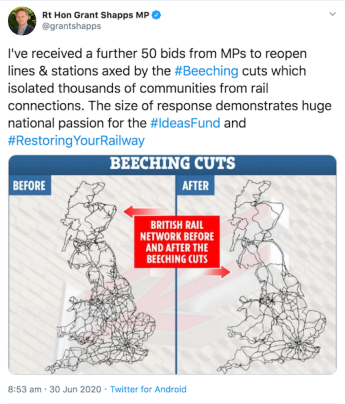
Meanwhile it was finally confirmed on Tuesday Newhaven Marine station will be closing, officially, “as early as September” after the recent consultation into its unofficial closure 14 years ago.

Good to see a number of operators are gearing up for an ambitious summer season attracting non-essential leisure travellers. City sightseeing operations are restarting in York next Saturday ….

…. while Seaford & District are hoping to be up and running to Eastbourne and Beachy Head in late July.
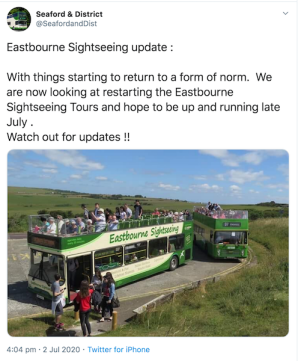
It’s also interesting to see some companies now positively promoting their services for leisure travel, with no reference to “essential travel only” and certainly no “avoid public transport”.
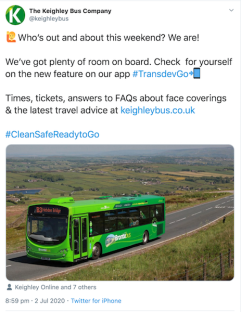
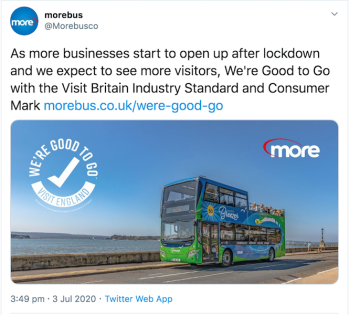
Once again, it looks Government will be in reactive mode playing catch up to ensure its messaging reflects what’s becoming the new practice, so good news in The Times on Friday that “public transport is likely to be opened up to thousands more passengers under government plans to drop official advice warning them to stay away. Ministers are preparing to tone down warnings over the use of trains and buses amid criticism from operators and backbench MPs that too many services are running empty”.

The Times has learnt that “Government will monitor use of public transport over the weekend and early next week before possibly abandoning the approach it has maintained since March. Over the past three months commuters have been told to use other forms of transport with buses and trains only used for essential journeys”.
I see Transport Focus Chief Executive Anthony Smith made the point very forcefully in a letter to the Secretary of State Grant Shapps on Friday calling for the negative messaging to end and it was good to hear Sir Peter Hendy confirming the likely upcoming change of stance ‘live’ from his homage-to-Dovey-Junction-store-room home during a keynote speech delivered to a webinar organised by Transport Focus and London Travelwatch on Friday.
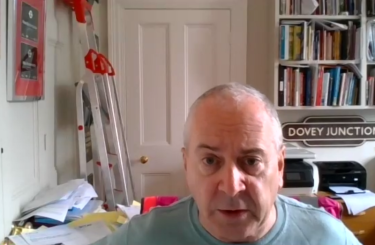
And this all comes just in time as Google maps displayed the grim picture on Friday afternoon of central London’s traffic back to its usual gridlocked level … despite the return of the congestion charge at an increased price and the ULEZ … confirming a car led recovery is well on its way.

So, as ‘normality’ beckons and travelling for leisure on public transport looks like being back on the agenda very soon allowing more normal blogging from me to also return, it’s time to bring these weekly round ups to a close. I hope you’ve enjoyed reading them as much as I have in putting them together.
I thought I’d end with a bang so have recorded a ‘vlog’ style presentation pulling the last 15 weeks together plus some action plans for the future into a fifty minute YouTube video entitled ‘How public transport survived a pandemic’. It’s launching at a special ‘live’ showing at 6.15pm on Monday (6th July 2020) as part of the London Transport Museum Friends recently established “At home with….” series of online presentations. So, if you’re reading this before the 6th July, do give it a watch and take the opportunity to join in the ‘live chat’. If you’ve missed it, don’t worry, it will still be on YouTube. Click here for the link.
A couple of spoiler alerts – re those action plans for the future, I make the point that if the DfT really are serious about rail fares reform, the time to do it is now – while they’re bankrolling the entire system and only 5% of revenue is at risk. I also make the point now is not the time to hand control of bus networks over to inexperienced (transport wise) metro Mayors – now is the time for well experienced transport professionals to show how to get costs to a manageable level and stimulate demand. Interestingly I see Mayor Burnham sensibly postponed a decision on bus franchising in Manchester last Friday. Every cloud.
Thanks for reading over the last fifteen weeks.
Roger French
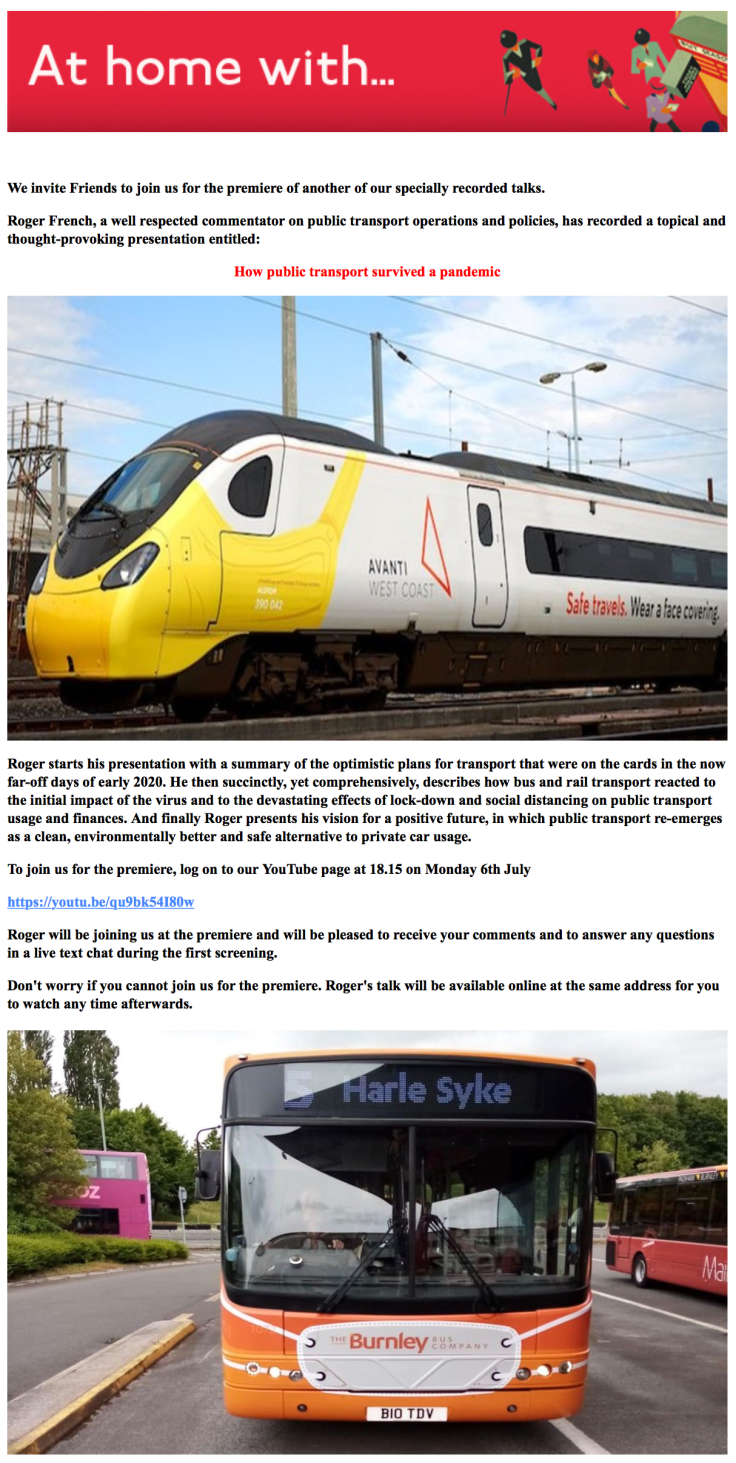


I can’t see much in the way of Improved train timetables from Monday up here in the North East. They look more or less the same as they have for several weeks – on the East Coast Main Line TPE are still only running hourly from NCL (50% of normal), XC only hourly (50%), LNER 3 per two hours (75%). On Northern, Newcastle-Hexham-Carlisle, normally 3 per hour to Hexham with 2 through to Carlisle, it is a single hourly service to Carlisle (about 40% of normal).
The XC timetable on their website is shown as valid from 6th July to 4th September, so they aren’t planning an uplift over the holiday period, when many staycationers might well be wanting to travel. Perhaps they know something about how the message might change…..
LikeLiked by 1 person
So Boris, Boris scooters?, has legalized e scooters on the roads.sadly this isn’t where 99 percent of the idiots who use them will be using them they’ll be on the pavement just like Boris’s Boris bikes before them.everything has to have a gimmick to it there’s already a perfectly good way to cover short distances and we’ve been doing it since the dawn of humanity…. it’s called walking.i don’t know how Boris e scooters are going to get down the pavement what with the cars parked on them, the bikes riding down them and the temporary road signs(for the benefit of motorists but never put on the road) blocking them ?e scooters are environmental snake oil like electric airliners and Musk/Branson’s hyperloops….what about the huge batteries under them how are they made and how do you dispose of them? changing the subject slightly to hyperloops a tube all the way from Los Angeles to San Francisco pumped down to 1 percent of Earth ground pressure, about the same as Mars’s atmospheric pressure.perhap Branson can explain how many vacuum pumps he’d need(a lot!)and what happens if someone shoots a hole in the tube? I’m going to guess it’d defeat most rifle rounds but something like a .50 BMG would probably go through?
LikeLike
The situation is not helped by the Rail Delivery Group publishing Supplementary Staff Travel Restrictions on behalf of Avanti West Coast, Great Western Railway and LNER stating that Rail Staff Travel leisure facilities should only be used if you
need to make a journey that is for a “Personal/family emergency that requires urgent attendance”. The RDG states “This supplementary set of restrictions has been introduced which are mandatory for staff to comply with.” In reality though many of the trains are practically empty and it is depressing to think that rather than use the most environmentally-friendly form of long distance transport we must drive for hours using previous fuel, with the stresses that can put on drivers.
LikeLike
Well said Mike. Plus of course make a compulsory seat reservation for a ticket you haven’t bought and don’t have if using a Staff Travel ‘box’ and using websites that don’t recognise this situation.
LikeLike
Thank you Roger, greatly enjoyed your informative weekly musings.
Invaluable summary of what’s going on.
It’s time someone asked the Queen to tap you on the shoulder with an offensive weapon and say ‘arise Sir Roger’
🙂
LikeLiked by 1 person
We already have,or had one, Sir Rodger Moore or was it Roger?
LikeLiked by 1 person
My apologies. Noticed on Roger’s excellent historical video presentation on these unprecedented times that the humble man is already a ‘Sir’ with an OBE. Well deserved too.
LikeLike
Greater Anglia are definitely increasing services. From their website:
We’re resuming a full timetable on most of our services from Monday 6 July, except for on our Stansted Express and Norwich-London intercity services – although we’re adding 12 extra services onto our intercity route across the day. Norwich to London intercity: Hourly service from 05.00 to 22.00. Plus additional services at 05.30, 06.48, 10.30, 11.30, 15.30 and 16.30.
London to Norwich intercity: Hourly service from 05.00 to 22.00. Plus, additional services at 08.00, 09.00, 13.00, 14.00, 17.50 and 19.02(Which doesn’t sound right, does it!!)
Stansted Express: Half hourly
LikeLike
School Buses
The government do not seem to have thought this through. In rural are most of the children travel by School buses or taxis and to keep costs down most of the buses a and taxis are full. In some cases they use feeder bus going into a hub too further cut costs. I cannot see how this can work with the bubble concept. The operators already struggle to provide the current level of schools services and will not have the additional buses and drivers available. I doubt the Councils would have the money to run the buses half empty although at this stage it is not clear what the government intends
The schools will start in September so not long to sort it out. May be they will allow the bus to run full as long as face masks are used . Who knows > Even that would not help lot
LikeLike
From “Wales Online” – the online version of the “South Wales Echo”: https://www.walesonline.co.uk/whats-on/travel/coach-companies-wales-coronavirus-lockdown-18535001
LikeLike
Just typical of the chaotic way in which Britain has handled the COVID 19 crisis. Policy making on the hoof leads to scenes like Bournemouth where if only one person had the virus in the morning, you can be sure that hundreds if not thousands had it by the evening. And a government quite happy to see relatively ‘clean’ Cornwall descended upon by the rest of the country. One guy had come to St Ives (Cornwall), was asked to wait his turn in the queue for a shop and replied that he had come to Cornwall to get away from all the social distancing!
The laughing stock of Europe!
On Sat, Jul 4, 2020 at 7:39 AM BusAndTrainUser – journeys around Britain by bus and tra
LikeLike
I’ll second the above comments thanking Roger for his very useful summaries over Lockdown . . . . I almost always find some new information contained therein.
I took my first train journeys on 4 July for 4 months . . . . passenger numbers were miniscule; social distancing was no problem; staff were comfortable about there being no need for face coverings on platforms, although at Oxford a staff member was partolling platforms offering face coverings for anyone that needed them . . . in summary, it was so good to be out and about again!!
I’ll make a couple of predictions here . . . . .
(1) as the “essential travel only” message has been quietly dropped, the requirement for face coverings on board buses and trains will be quietly dropped soon as well.
(2) I’d expect the concerns about social distancing on school buses to be dropped in early August . . . . so if I was running a coach company with school contracts, I’d sit tight for now and not waste any money on pointless seat notices! I feel sorry for the likes of Stagecoach and Blazefield that have tried to do the job properly and spent many £’000’s on vinyls.
(3) all bus services and most train services to be back to normal timetables by early September (quite possibly in August in Scotland). InterCity services may not return so quickly . . . . the leisure market will be more fickle, with the usual travellers not being so keen on a 5+ hour journey with no refreshments and limited toilets! Good Luck to Grand Central . . . . I hope they have large pockets!!
LikeLiked by 1 person
Ah the inconsistency of it all. . Face masks on trains and buses and social distancing distancing and no food but get on a plane and no need to social distance but you do need a face mask but interestingly Ryanair are serving food and the only way to eat it is to remove the face mask. Whether that complies with the legislation who knows but the airlines seem to be a law to themselves
LikeLike
May I add my thanks to you, Roger, for the superb and entertaining weekly round-ups. I have learned alot and I have found myself agreeing with you every time.
Let’s hope the official discouragement from using public transport – which looks ridiculous now following yesterday’s changes – ends very soon.
LikeLiked by 1 person
I saw someone remove a face mask to cough catching it on hand!an automatic response I suppose?they need to get little wedges on the trains and buses which have opening windows and wedge them open non stagnant air would be a very sensible thing.i don’t know why but people love closing the windows even on hot days almost as if common sense has been bypassed.
LikeLike
I can just imagine buses running through the depths of winter with their windows secured wide open and saloon heaters turned off (opening windows on trains are just a memory in most areas), meanwhile those using private cars endure no such conditions. Another own goal by public transport as the car-led recovery gathers yet more pace.
LikeLike
Kim -it is not an own goal. It is a goal scored by the opposition wearing your kit whilst your team were reading the revised laws of the game which were also written by the goal scorer who just happens to be the referee as well.
In other words, the Minister of Transport is not on the side of public transport.
LikeLike
If we are not careful we will end up with the equivalent of a Beeching on the buses.
(That tried to spell check as belching but with a face mask all would be well)
LikeLike
Roger – I have found your write-ups a compelling analysis of the situation, week-by-week.
As we ease out of the pandemic, it is uncertain how much the government will be involved in public transport. And in their eyes, the objective may be to improve the environment, rather than increase bus-use.
I believe that hands-on creativity of operators will need to increase, looking beyond ENCTS and ‘green bus-type’ funding, and the compliance with health & safety, accessibility and environmental requirements, which in themselves may not attract passengers.
You can compare buses to traditional pubs; established for decades, but often ‘down-at-heel’ in a number of ways and struggling for custom. Most people can use cars to make a journey, whilst shopping and socialising can be based online.
However, micro-pubs and restaurants are increasingly popular. And in a different sphere, so are the best park & ride schemes. People are attracted because they want to use what is offered. It is more a lifestyle choice than a necessity.
Customers are greeted at the restaurant with table service, whilst park & ride sites may have duty staff assisting customers, encouraging a bus ride to the heart of the city or visitor attraction.
Similarly, historic transport events also work well on these principles – classic buses have a ‘chaperone’ alongside the driver, to engage the passengers who become enthralled with the vehicle and donate generously to the preservation cause.
Could service bus operators emulate this? A revival of services will need local, human points of contact rather than distant, generic ones.
Customer assistants at busy locations could keenly combine the traditional virtues of the bus conductor, duty inspector and travel office – speed-up boarding, assist the less-able and have basic knowledge of local timetables, ticket prices and use of wheelchair ramps and bays.
Greeting the queue to sell tickets in advance with hand-held machines, quoting the prices e.g. “only £2 single, £3 return, £5 all-day, last bus back ten-to-nine tonight….”. Most users are merely looking for simple information. Growth on quieter journeys may also be encouraged.
The roles would be ongoing, and not one-off secondments from elsewhere in the company to cover e.g. a service revision. They would suit part-time shifts by keen students, and experienced workers (maybe from driving or hospitality jobs) easing down to retirement. The main criteria would be calmness and motivation.
Reasonable terms and conditions of employment should be negotiated e.g. a minimum set of hours weekly and they should not be ‘stood down’ at whim, if a quieter day is anticipated.
The trade union(s) should be involved from the beginning, and made aware of the overall benefits. Their member drivers would have ultimate responsibility for fares and safe-carriage of passengers, but at busy points on the network, the assistance of a colleague will benefit all.
LikeLike
Customer assistants were tried by TfL but were not really successful and with the advent of the Oyster card and pre pay travel they become pointless. If they did not work in London they are not going to work elsewhere and they add considerably to costs
Should bus companies look to having more flexible routes and timetables. You have different travel patterns at peaks to off peak and at weekends but bus companies work on the one timetable fits all and it simply does not
The bus companies as well could utilize schools buses during the day rather than leave them parked up in a garage most of the day. Councils could assist with this asd they pay a lot for school journeys and they could utilize value from these contracts for off peak day time services
LikeLike
Bob, I am not familiar with London at the present time, but elsewhere buses are often run from a distant HQ, with drivers mostly dealing with things locally, which is quite onerous for them at times. If things do not go to plan, there is often no remedy at hand.
And whilst the Prime Minister “loves buses”, those in the wider government may be less keen, having been brought-up with car use.
You don’t normally see families board a bus other than at park & rides or transport running days, where they are more likely to receive a relaxed, cheery welcome, with more than one person involved in operating the journey.
Prospective users prefer human inter-action, just as they prefer paying a checkout assistant rather than a clunky self-service machine that can’t help you if something goes wrong.
Buses are a solution to environmental problems, but are fighting for their very existence, as many households don’t use them, and government isn’t necessarily keen on them.
The corporate rigidity needs to be reduced, and a more entrepreneurial breed of bus person is needed to run things locally, inspiring the drivers to think likewise, to get the wider population aboard.
LikeLike
Flixbus has confirmed its entry into the Intercity market. It has announced plans to carry several million passengers in the first 12 months
I doubt there is room for 3 players in the market in fact I think the current two will struggle. One I think will fold. Which one who knows
LikeLike
Flixbus have their continental routes to fall back on should they fail basically they seem to have taken over Eurolines routes.Megabus doesn’t have much fall back.National Express as the former incumbent state operation is likely to survive.most likely Flixbus will take over Megabus’s routes.
LikeLike
“Bob” has said, “The bus companies as well could utilize schools buses during the day rather than leave them parked up in a garage most of the day.” Isn’t this what often happens already, especially in rural areas, being the only viable way to run a service?
However it’s not ideal as the buses aren’t able to service the morning rush hour, and “holes” are left in the schedule in mid-afternoon. I would imagine too that one couldn’t cover the evening rush hour either as this would make the drivers’ shifts too long. Roger, can you comment?
LikeLike
Yes; that’s how it often works.
LikeLike
Bob . . . . . it’s a good idea, and in many cases that’s what happens on surviving rural routes . . . . have a look at Intalink.org and search for Route 305 . . . . . I’ll declare an interest; it’s my company that operates this route . . . . but it’s a good example anyway.
The route runs an AM peak trip that also covers one school directly and several others indirectly. Four villages (all quite close to St Albans) receive a shoppers service. There is a school return trip and a PM peak trip. One bus and one driver, who is worked pretty hard, is all that is required.
It is a Herts CC contracted service, and before C-19 probably covered around 25% of its costs in revenue, so that’s support of c£75K pa. Average school term passenger numbers were around 125 passengers per day. That’s around 38K passengers per year, so the support looks like around £2 per passenger.
This is a rural route in an urban setting, so passenger numbers are probably quite high by comparison with a deep-rural route.
Before 2012, when Dorset CC slashed almost all their supported rural bus routes, they worked on an average of 10 passengers per hour as being worthy of support. Very many routes didn’t survive; those that ran an AM peak trip, two shoppers trips and two PM peak trips either needed 1.5 drivers to cover a 12 hour day, or had substantial holes in the timetable to keep driving hours under 10 hours (including garage runs).
As I’ve said before . . . . rural shopping trips rely on Mrs Scroggins going to market or the doctors. You need a lot of Mrs Scroggins’ to make the sums add up, and regrettably Mrs Scroggins is now dead or in a retirement home, so doesn’t travel.
Rural buses as we knew them have had their day . . . . Government trying to restore them (or un-Beeching railway closures) are simply not in touch with modern travel patterns. The bus industry, given a fair wind, will provide, on a commercial basis:
1. Quality high-frequency urban bus routes.
2. Quality inter-urban bus routes serving several communities together.
3. Quality Park and Ride services, thereby keeping towns and cities pleasant places to visit with good air-quality.
All else should be sacrificed, unless Local Government wishes to buy them in, and will be prepared to pay the price. Such services “could” be provided as Bob suggests, and if the local coach operator gets involved, probably at the lowest price.
Dial a Ride, or whatever the posh name is today, is simply a diversion . . . . it was tried in 1974 and didn’t work then . . . . so why should it work now??
Sorry to rant on . . . . but after 45 years experience watching Government just not looking at the evidence . . . . I really do despair . . . .
LikeLiked by 1 person
In the rural counties where most children travel to school by bus or taxi there are plenty of spare buses after the school run.
Generally the schools start about 9:00 with the buses arriving at about 8:40so the buss are free to do a scheduled service from about 9am, In the afternoon they ill be needed for the school pickup from about 15:20 . So the bus would be available from about 9am to about 2:30pm . There could be a break i the service at lunch time which is a quiet period any way to allow the drive to take his lunch break
The services would only run Mondays to Fridays. This would enable quite reasonably service to run in the rural towns at low cost. The real rural service would probably need to use the Dial Ride type services unless they were lucky enough to be on an Inter Urban Route
LikeLiked by 1 person
Bob . . . . . absolutely right; with some joined-up thinking between Education and Transport Planning departments in local Government, this is what should happen and would provide essential transport for those without access to a car.
Unfortunately, joined-up thinking is rare; Transport Planning is now a sub-division of Transport and Roads in most Counties, and those who know and understand buses are now retired (it is over 30 years since they were recruited following job cuts with deregulation and NBC privatisation).
Operators see this all the time . . . . make innovative suggestions about linking school and shopping services together, but regrettably see their ideas fall on stony ground . . . . in many cases because subsidy would still be required, and subsidy isn’t available. The school contract may pay for the bus and half of the driver each day, but with very few daytime passengers (and almost all passholders at 50% of the adult single fare), even the balance won’t be covered by fares.
When Oxfordshire pulled all rural bus service revenue support in about 2014, some routes were retained commercially for short periods, often when operators had buses spare in the daytime and tried to cover costs with fares income only. Most of those initiatives have withered away; simply not enough passengers travelled to cover basic costs. There have been few requests for any of these services to be re-instated . . . . there wouldn’t be any passengers now!!
LikeLike
Bob and Greenline you are theoretically correct. However many school contracts are operated with coaches because Education Authorities demand that vehicles are fully seatbelted. In this area buses which carry statutory pupils also have to have seat belts fitted. Coaches are not always DDA compliant so cannot be used on bus services. Many rural journeys were withdrawn in some areas at the end of last year by operators who used coaches on bus services rather than purchase buses or new DDA compliant coaches to comply with the new legislation.
LikeLiked by 1 person
Very few councils specify coaches for school bus services
There is a lot of opportunity to use the schools bus during the day to provide reasonable frequency town services off peak, If it is kept to Monday to Friday and the service stops for the drivers lunch break it keeps costs down
There is a lot of value in the Schools services that can be unlocked and used to help fund the off peak services. Town services could attract 3 to 6 passengers per trip and you could probably run 2 trips an hour
If an open book policy was operated on these service then the government could relax the ? Concessionary pass scheme and if they would be loss making allow for a small fare to be charged for concessionary pass holders say £0.30. The only issue might be confusion over which service pass holders can travel for free and which ones they will have to pay a fare. The routs that they have to pay a fare could have a unique Prefix letter and plenty of signage
LikeLike